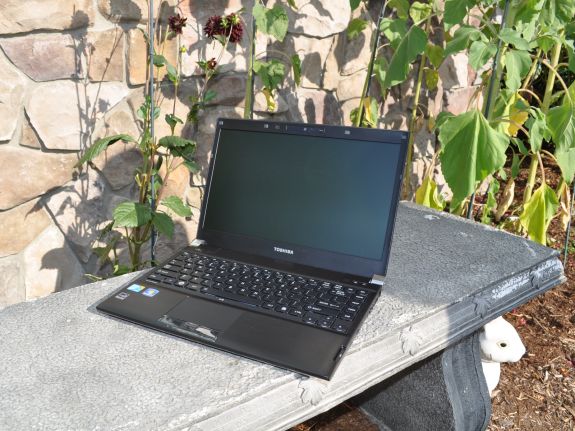Toshiba Portege R700: A Truly Ultraportable 13.3"
by Vivek Gowri on September 7, 2010 6:01 PM EST- Posted in
- Laptops
- SSDs
- Toshiba
- Portege R700
Toshiba Portege R700—Introduction
Toshiba Computer released Japan’s first notebook computer in 1985, instantly cementing Toshiba as one of the pioneers of mobile computing. Since then, Toshiba has consistently been amongst the sales leaders of consumer notebooks in the US. But for all their mainstream success, in recent times Toshiba has not had any particularly compelling designs out there. There’s a lot of systems in the same vein as the A505 we tested earlier this year—vanilla mainstream notebooks that offer a lot of glossy black plastic to go along with a good amount of value, but no really compelling portable systems like the Portege R100 or R400 tablet from the past. Until now, with the introduction of the new Portege R700 and R705.
The R700 is Toshiba's latest ultraportable, and on paper, it's very impressive. It uses regular voltage Core i3, i5, and i7 processors and manages to stuff an optical drive into a 3.2lb, 1" thick enclosure. The casing is all done in brushed aluminum, and the internal structure uses a magnesium alloy and features an aluminum honeycomb to dissipate heat. The result is a notebook that is reportedly both lighter and stiffer than the previous Portege R500 and R600 notebooks. Unfortunately, like most other non-ASUS ultraportables, the R700 uses the onboard Intel HD graphics instead of going for a discrete graphics card, but given the 1” thin, 3lb form factor, it’s an understandable concession to make.
| Toshiba Portege R700-S1330 Specifications | |
| Processor |
Intel Core i7-620M (2.66GHz, 32nm, 4MB L3, 35W) |
| Chipset | Intel QM57 Express |
| Memory |
2x2048MB DDR3-1333 Max 2x4GB DDR3-1333 |
| Graphics | Intel HD Graphics (64MB—1696MB shared memory) |
| Display | 13.3" LED Backlit Matte WXGA (1366x768) |
| Hard Drive | 2.5" 320GB 7200RPM SATA (Seagate ST9320423AS) |
| Networking |
Intel 82577LM PCI-E Gigabit Ethernet Intel Centrino Ultimate-N 6200 802.11a/b/g/n |
| Audio |
Realtek AL269 2-Channel HD Audio (2.0 Speakers with headphone/microphone jacks) |
| Battery | 6-cell Lithium-ion, 5800 mAh, 10.8V, 66 Wh |
| Front Side | None |
| Left Side |
AC Power Connection VGA Port 1 x USB 2.0 eSATA/USB Combo Port HDMI port |
| Right Side |
5-in-1 memory card reader Integrated DVD SuperMulti Drive ExpressCard slot Headphone jack 1 x USB 2.0 Gigabit Ethernet Kensington Lock |
| Back Side | None |
| Operating System | Windows 7 Professional 64-bit |
| Dimensions | 12.44" x 8.94" x 0.66-1.01" (WxDxH) |
| Weight | 3.0lbs (SSD), 3.2lbs (hard drive) |
| Extras |
Bluetooth 2.1 Integrated webcam and microphone |
| Warranty | 1-year battery warranty |
| Pricing | Portege R700-S1330 from $1489 at ProVantage |
The R700 starts at $999, but our $1599 R700-S1330 test unit features top of the line components—the 2.67 GHz Core i7-620M, a 128GB SSD, and 4GB memory. For a 3.0lb machine with eight hours of battery life on tap, that’s a lot of power. The "little brother" Portege R705 is a really interesting configuration though. It shares the same chassis as the R700 (with a blue-painted lid), but has a Core i3-350M, 4GB of RAM, a 500GB hard drive, and trades the ExpressCard slot and docking capabilities for Intel’s WiDi built in. For a price of $829, that’s pretty awesome, especially when you take into account the completely aluminum chassis and 3.2lb carrying weight (R700/705 models with hard drives weigh slightly more than the 3lb SSD test unit we have). So on paper, the R700 finally brings something special to Toshiba’s otherwise-ordinary lineup, but does that impression hold up in person?











43 Comments
View All Comments
Jon_Irenicus - Friday, September 10, 2010 - link
I found the info and comparisons with other laptop lcds very informative. Was wondering if the same lcd review treatment could be done on an hp envy 14 with the radiance display option, and the 8740w elitebook with the dreamcolor display option seen herehttp://forum.notebookreview.com/notebook-news-revi...
In the charts posted here the vaunted rgbled display from dell blew all others away in most tests, that display is put side by side in in alienware vs the elitebooks 10 bit ips panel and it trounces it in viewing angles.
Be interesting to see how it fares on these charts with the other monitors, so far there are other panels people are not seeing in the lineup, hopefully hp can send a review unit.
TareX - Saturday, September 11, 2010 - link
So how does this compare to the 1215n? That's really what I care about.... which is better for games, and for flash HD in the browser?I4U - Saturday, October 9, 2010 - link
I'm using a cheaper version (13n) than this one you tested and the toshiba takes the place of a Thinkpad T61. I'm really delighted with the display! The color setup is excellent, the screen is really bright at maximum and the matte treatment is excellent.I don't know if the Thinkpad is really horrific, I don't know if lcd displays have made so much progress since the last 2 years, but it's for me a real pleasure to use this screen.
About the flex of the lid: the Thinkpad which is considered as really sturdy, especially for the lid has also a flex and I'm amazed Toshiba has been able to make a so sturdy device in 3lbs.
Another point: the 3G module included in the 13n version is the excellent ericsson f3607gw: 3G+, GSM, GPS and WoW (wake on wireless): with the tpm intel platform and a core i5-5xx, you get the best trusted platform available (antitheft technology).
Thank you for your wealthy analysis!